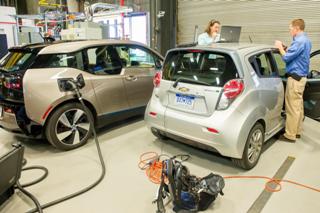Dec 14 2015
As electric vehicle sales continue to rise around the world, the European Union opened the first European Interoperability Center for Electric Vehicles and Smart Grids last month to make sure all these cars have a standard plug and equipment that can work anywhere.
 The Interoperability Center held a "Testival" last November at Argonne to pair up as many DC Fast Charging stations with as many plug-in electric vehicles or vehicle emulators as possible to test their interoperability. The event prompted a greater response than expected, drawing more than 30 electric vehicle supply manufacturers and automotive manufacturers from at least eight countries. Credit: Argonne
The Interoperability Center held a "Testival" last November at Argonne to pair up as many DC Fast Charging stations with as many plug-in electric vehicles or vehicle emulators as possible to test their interoperability. The event prompted a greater response than expected, drawing more than 30 electric vehicle supply manufacturers and automotive manufacturers from at least eight countries. Credit: Argonne
The new center in Ispra, Italy, is part of the European Commission's Joint Research Centre and is a sister location to the U.S. Electric Vehicle-Smart Grid Interoperability Center, which opened at the U.S. Department of Energy's Argonne National Laboratory in 2013.
The goal for both centers is to help write codes and standards and to create and demonstrate equipment to ease the transition as electric vehicles become more popular globally.
Argonne Director Peter Littlewood spoke at the inauguration, describing it as a unique opportunity to "collaborate on technologies that will lead to cleaner, smarter and more integrated transport and energy on both sides of the Atlantic."
The past 15 years have seen more and more car companies releasing hybrid and electric models, but especially in the early days, their charging equipment and plugs weren't uniform.
"The ultimate goal is to have a completely interoperable charging structure across the world," said Argonne's Keith Hardy, who leads the U.S. center. "The plugs can be different, but we can coordinate the communication protocols."
At minimum, the car has to talk to the charging station for identification, authorization and billing, he explained, and to determine how much energy the battery needs and how fast it can be charged.
Hardy said the communication will be more sophisticated in the future and could include driver preferences, such as a specific time that the charge needs to be complete (e.g., when you want to leave for work), charging only when the electricity price is below a specified limit or even waiting until renewable energy is available.
"Most control signals, power and safety requirements are harmonized for AC charging in Europe and the U.S.," Hardy said. "Standards committees expect to complete DC standards in 2016." They're also working on wireless charging.
In the two years since it opened, the Argonne center has drafted international standards for electric vehicle interoperability testing and equipment. They also develop physical devices, such as a universal electronic module to connect vehicles and other devices to the grid.
Vehicles also need to be able to talk to the grid, Hardy said, to help utilities maintain service as more cars draw electricity.
"We also want to harmonize vehicle and battery test procedures," Hardy said, so that results are similar even when tested in different labs. Right now, Argonne is testing a reference vehicle--a BMW i3 range-extended electric car--and then will ship it to Italy to compare results and procedures in their lab.
Hardy said the two centers plan to exchange researchers as well as vehicles and instrumentation in the future.
"This helps make sure our work in transportation and the grid has maximum impact around the globe," he said.